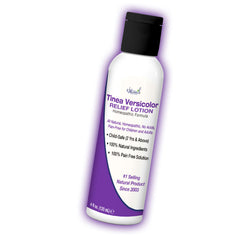What is ringworm?
Ringworm is the collective, common term for a series of related, highly contagious, fungal skin conditions. Despite its name, ringworm is not caused by a worm; instead, this refers to the condition’s typical rash, which is circular, raised, and usually red, with a center that is the same as your usual skin tone. This rash is caused by a type of fungus known as dermatophytes. These fungi like to live and multiply around the keratin in your body, which is why they are particularly prevalent in hair follicles, where there is a steady supply of keratin (the protein that hair and nails are made of) for them to consume. [1]
The generic term ‘ringworm’ usually refers to tinea corporis, otherwise known as ringworm of the body. However, ‘ringworm’ can also affect the scalp (tinea capitis) or the groin (tinea cruris, or ‘jock itch’). As each of these conditions can cause slightly different symptoms, it is important to understand the particular type of ringworm that you are suffering from so that you can effectively treat the condition before it worsens or spreads.
Tinea Corporis (Ringworm of the Body)
Symptoms of Tinea Corporis
1-3 weeks after exposure to the dermatophytes that cause tinea corporis, you may notice a ring-shaped rash or scaly patch on your skin. [2]This can be circular or oval in shape and may be flat at the beginning and then become raised over time.
The lesions are usually red or pink, though on darker skin tones, they may appear brown, purple, or gray. The skin to the center of the lesion is usually the same color as your natural skin tone.
The most common parts of the body where the rash occurs are the upper arms, legs, neck, back, and chest - though it is not uncommon for the rash to spread if left untreated.
Causes of Tinea Corporis
While anyone of any age could catch ringworm, it is particularly common in teenagers and young adults. [3] This is likely because of several factors. Firstly, people of this age are more likely to come into close contact with others who have the condition; generally, the most common way of transmitting the dermatophytes that cause ringworm is by touching the skin of or using the same clothes and towels as someone else with the condition. Ringworm can also be caught from close contact with pets, including dogs and cats, who are currently suffering from the condition. [4]
Secondly, another likely place to catch ringworm is while taking part in close-contact sports, including martial arts and wrestling. It can also be caught from shared sports equipment and when using communal facilities like locker rooms and showers, where the warm, humid conditions allow for easy transmission. [5]
The dermatophytes that cause tinea corporis are prevalent across the world, with between 10-20% of people worldwide suffering from a case of tinea corporis at some point in their lives. [6] However, the dermatophytes are particularly suited to hot, humid conditions. This means that cases of ringworm are more common in tropical and subtropical climates. [7] Because the dermatophytes like to live and multiply in moist conditions, you are more likely to get a case of ringworm if you are regularly sweaty or if you have oily skin. Wearing tight clothing that is not made of breathable fabric can, therefore, also contribute to the chances of contracting a case of ringworm. [8]
In addition, if you are experiencing hormonal changes in your body, you may be more at risk of ringworm due to many factors, including the changing pH of your body’s chemistry. [9] Finally, medical conditions like diabetes or a reduced immune system may also lead to a greater chance of contracting ringworm since your body’s natural defenses are weakened and less able to deal with the rapidly reproducing dermatophytes. [10]
Tinea Capitis (Ringworm of the Scalp)
Symptoms of Tinea Capitis
Just like tinea corporis, tinea capitis is a fungal infection of the hair follicles. The dermatophytes reproduce on the scalp, consuming keratin in the follicles for their growth. Because the scalp is thick with hair, the symptoms of tinea capitis are a little different from the trademark ringworm rash. Instead, it is likely to see patches of hair missing, inflammation of the scalp, and even small marks or pustules on the scalp. It can also cause itching and discomfort. [11]
Causes of Tinea Capitis
Just like the other forms of ringworm, tinea capitis can be caught by anyone of any age. However, tinea capitis is much more prevalent in children. The condition most commonly affects children aged between six and puberty; some studies show that it is most common in African American children. [12]It is typical in this age group due to the close proximity of children at this age, particularly at school and when playing with friends.
Like tinea corporis, tinea capitis is likely to be caught through close contact with another person with the condition. However, ringworm of the scalp is also commonly caught by sharing pillows, hats, brushes, combs, and barbershop equipment with a person who has a current case of the condition. [13] This means that if you are living in close proximity to other family members with the condition, you are more likely to contract a case of tinea capitis too.
Tinea Cruris (Jock Itch or Ringworm of the Groin)
Symptoms of Tinea Cruris
Like tinea corporis, tinea cruris (ringworm of the groin) usually looks like a rash consisting of one or a number of round, discolored patches or lesions with a raised edge. The skin to the center of the lesion may be the same as your usual skin color, and the rash may occur across your groin or pubic area, the buttocks, or the inner thighs. [14] If not treated properly, it is likely that the lesions will spread.
Causes of Tinea Cruris
Tinea cruris, like all kinds of ringworm, is highly infectious and can be transmitted from person to person easily - particularly through close contact and sharing towels, clothes, and sheets with a person who has a current case of jock itch. Currently, while prevalent across the world, jock itch is more common in men. [15]
Though tinea cruris is not technically a sexually transmitted infection, close proximity during sex does make transmission more likely. [16]Shaving is another risk factor since it can cause damage to the hair follicles where the dermatophytes like to live. In addition, wearing tight-fitting clothing made with synthetic fibers may also lead to a higher likelihood of a case of tinea cruris since the dermatophytes are better able to grow and reproduce in moist, warm conditions.
Treatment of Tinea Corporis, Tinea Capitis, and Tinea Cruris
When dealing with ringworm - whether tinea corporis, tinea capitis, or tinea cruris - it is important to soothe the skin and relieve discomfort while still tackling the fungus at the source.
Natursil’s ringworm products - including our Ringworm Treatment and our Jock Itch Treatment - offer an effective and clinically proven yet safe and natural solution to all kinds of ringworm. With studies indicating that natural antifungal remedies are actually more effective in curing ringworm and jock itch than the traditional chemical formulas - with significantly fewer side effects reported, too - our homeopathic ingredients have your safety and comfort in mind. [17]
Use the easy application brushes to apply our solutions topically to the affected areas two to three times per day for one to three weeks or until symptoms of the fungal infection have disappeared. Unlike over-the-counter treatments, our solutions sink into the skin, allowing the remedies to penetrate deep into the hair follicle. This allows the sulfuric compounds, known for their antifungal properties, to reach and eliminate the dermatophytes at their source. In addition, our treatments include soothing, natural ingredients like lavender, jojoba, and eucalyptus oils. These get to work on easing the itching and irritation, promoting healing of the affected areas.
To prevent recurrent cases of tinea corporis, try to wear loose-fitting clothing that is either made of breathable fabrics like cotton or synthetic fabrics designed to wick moisture away from your body. [18]This will make the conditions on your skin less favorable for the dermatophytes to live and reproduce, thus reducing your chances of contracting ringworm.
Even after your symptoms have cleared up, make sure to wash your body thoroughly, using an effective cleansing product, since it is not uncommon for cases of ringworm to recur. With its antifungal properties, our Sulfur Soap is an excellent preventative product to add to your daily routine. Next, dry your body fully, and avoid sharing clothes, towels, or bedding with anyone else who has a case of ringworm or jock itch, too. [19]Maintaining good personal hygiene, keeping cool and dry, and avoiding touching the affected areas of others are all keys to keeping your body ringworm free.
[1] Sahoo, A.K. and Mahajan, R., 2016. ‘Management of tinea corporis, tinea cruris, and tinea pedis: a comprehensive review.’ Indian Dermatology Online Journal, 7(2), 77-86.
[2] Leung, A.K.C., Lam, J.M., Leong, K.F., and Hon, K.L., 2020. ‘Tinea corporis: an updated review.’ Drugs in Context, 9, 5-6.
[3] Leung, et al., 2020.
[4] Leung, et al., 2020.
[5] Adams, B.B. (2002). ‘Tinea corporis gladiatorum.’ Journal of the American Academy of Dermatology, 47(2), 286-290.
[6] Leung, et al., 2020.
[7] Sahoo and Mahajan, 2016.
[8] Ibid.
[9] Ibid.
[10] Ibid; Adams, 2002.
[11] Elewski, B.E., (2000) ‘Tinea capitis: A current perspective.’ Journal of the American Academy of Dermatology, 42(1), 1-20.
[12] Gupta, A.K. and Summerbell, R.C. (2000) ‘Tinea capitis.’ Medical Mycology, 38(4), 255-287.
[13] Elewski, 2000.
[14] Singh, S.K. (2018). Diagnostics to Pathogenomics of Sexually Transmitted Infections. London: Wiley Blackwell.
[15] Singh, 2018.
[16] Ibid.
[17] El‐Gohary, M., van Zuuren, E.J., Fedorowicz, Z., Burgess, H., Doney, L., Stuart, B., Moore, M., and Little, P. (2014). ‘Topical antifungal treatments for tinea cruris and tinea corporis.’ Cochrane Database of Systematic Reviews, 8.
[18] Sahoo and Mahajan, 2016.
[19] Ibid.






